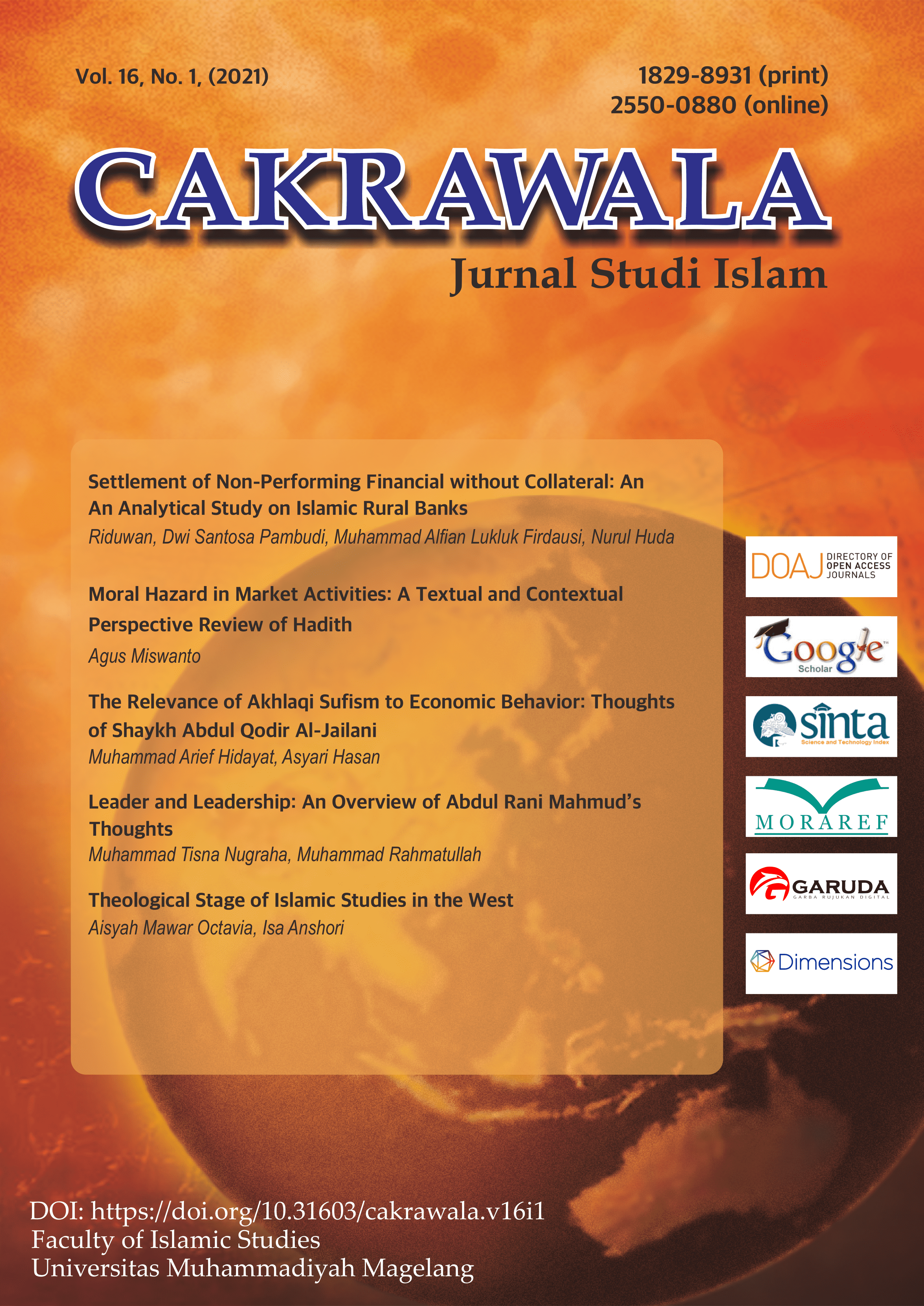Main Article Content
Abstract
The purpose of this research is to analyze at the moral hazard of market activity in the Prophet's hadith. The market is a place where traders can engage in economic activity in order to make a profit. Some traders are forced to compromise their morality due to profit motivation. This is a qualitative descriptive research. This study employs the hermeneutic method, which entails examining the text and context in order to fully comprehend the prophet's hadith. The findings of this study show that Allah despises the market, which is an expression of the prophet's feelings about the types of market activity carried out by traders that are prohibited by Shari'a. Usury, gharar, and maisir are examples of traders' moral hazard behavior, which causes injustice and harm to third parties.
Keywords
Article Details

This work is licensed under a Creative Commons Attribution-NonCommercial 4.0 International License.
References
- Al-Bani, N. (1988). Sahih al-Jami’ al-Shagir wa Ziyadatuh (3 ed.). al-Maktab al-Islami.
- Al-Bukhari, A. A. M. bin I. (2001). Sahih al-Bukhari (Cet. 1). Dar Ibn Katsir.
- Al-Dharri, H. S. (2000). Abu Hurairah Shahib Rasulillah wa Khadimuhu (1 ed.). Dar al-nafais.
- Al-hakim, A. A. M. bin A. (2002). al-Mustadrak ’ala al-Sahihain al-Juz al-Tsani (M. A. Q. ’Atho (ed.); 2 ed.). Dar al-Kutub al-’Ilmiyah.
- Al-Khatib, M. U. (1982). Abu Hurairah Riwayatul Islam (3 ed.). Maktabah Wahbah.
- Al-Tirmidzi, M. bin I. bin S. (1977). al-Jami’ al-Sahih-Sunan al-Tirmidzi (A. Syakir, M. F. Abdulbaqi, & I. ’Athwah ’Iwadh (ed.); 2 ed.). Mustafa al-bab al-halabi.
- Anas, M. Bin. (1985). al-Muwatha’ (M. F. A. Baqi’ (ed.); 1 ed.). Dar Ihya al-Turats al-Islami.
- Antonio, M. S. (2008). Muhammad SAW: The Super Leader Super Manager (N. M. Ali & C. H. Sholehudin (ed.); 9 ed.). Pro LM.
- Awad, J. A. (1989). Islamic souqs (bazaars) in the urban context : the Souq of Nablus. Kansas State University Manhattan, Kansas USA.
- Baker, T. (1996). On the Genealogy of Moral Hazard. Texas Law Review, 75(2), 237–292.
- Djelic, M., & Bothello, J. (2013). Limited liability and its moral hazard implications : the systemic inscription of instability in contemporary capitalism. Theory and Society, 42(6), 589–615. https://doi.org/10.1007/s11186-013-9206-z
- Ibn-Mandzur, A. M. bin M. (2002). Lisanul Arab al-Mujallad al-’Asyir. Dar Shadir.
- Katsir, A. F. I. bin U. bin. (1998a). Tafsir al-Qur’an al-’adzim al-Juz al-Sadis (S. bin M. Al-salamah (ed.); 2 ed.). Dar al-Thaibah li an-nasyr wa al-tauzi’.
- Katsir, A. F. I. bin U. bin. (1998b). Tafsir al-Qur’an al-’Adzim al-Juz al-Tsamin (S. bin M. Al-salamah (ed.); 2 ed.). Dar al-Thaibah li an-nasyr wa al-tauzi’.
- Khalil, S. A. (2003). Atlas of the Qur’an: Places, Nations, and Landmarks (1 ed.). Darussalam.
- Khoiruddin. (2010). Pasar Islam. ASAS, 2(2), 61–72.
- Kotowitz, Y. (1989). Moral Hazard. In J. Eatwell, M. Milgate, & P. Newman (Ed.), Allocation, Information and Markets (hal. 207–208). Palgrave Macmillan. https://doi.org/https://doi.org/10.1007/978-1-349-20215-7_21
- Laffan, M. (2015). Sejarah Islam di Nusantara (M. Azis & A. Hadiyono (ed.); 1 ed.). Bentang.
- Mahfudz, A. A. (2014). Pasar dan Instrumen Keuangan Islam (1 ed.). Universitas Terbuka.
- Miswanto, A. (2019). Ushul Fiqh: Metode Istinbath Hukum Islam (Z. B. Pambuko (ed.); 1 ed.). Magnum Pustaka Utama.
- Muhammad. (2004). Etika Bisnis Islami (1 ed.). UPP AMP YKPN.
- Najwah, N. (2008). Ilmu Ma’anil Hadis Metode Pemahaman Hadis Nabi: Teori dan Aplikasi (1 ed.). Cahaya Pustaka.
- Pishqadam, M., & Bahrami, B. (2019). Study on The Evolution of The Nature of Bazaar in Shiraz: From Traditional Bazaar to Modern Shopping Malls. the 4 International Conference on Researches in Science & Engineering.
- Rowell, D., & Connelly, L. B. (2012). A History of the Term Moral Hazard. The Journal of Risk and Insurance, 79(4), 1051–1075. https://doi.org/10.1111/j.1539-6975.2011.01448.x
- Shah, F. bin A. (2013). Perkembangan Metode Pemahaman Hadis di Malaysia. Analytica Islamica, 2(2), 193–216.
- Sirojudin, M. R., Abdurahman, & Bayuni, E. M. (2018). Moral Hazard di Lembaga Keuangan Syariah Menurut Pandangan Islam. In D. Ahmadi, Muhammad Roji Iskandar, A. Nurrahman, M. Suherman, & S. Diari (Ed.), Prosiding Keuangan dan Perbankan Syari’ah (hal. 326–333). UNISBA.
- Utaberta, N., & Asif, N. (2019). The Role of Traditional Market in the Traditional Islamic Cities: Case Studies of Tabriz Bazaar and Grand Bazaar Tehran. International Journal of Engineering and Technology, 8(1.9), 622–625. https://doi.org/10.14419/ijet.v8i1.9.30074

